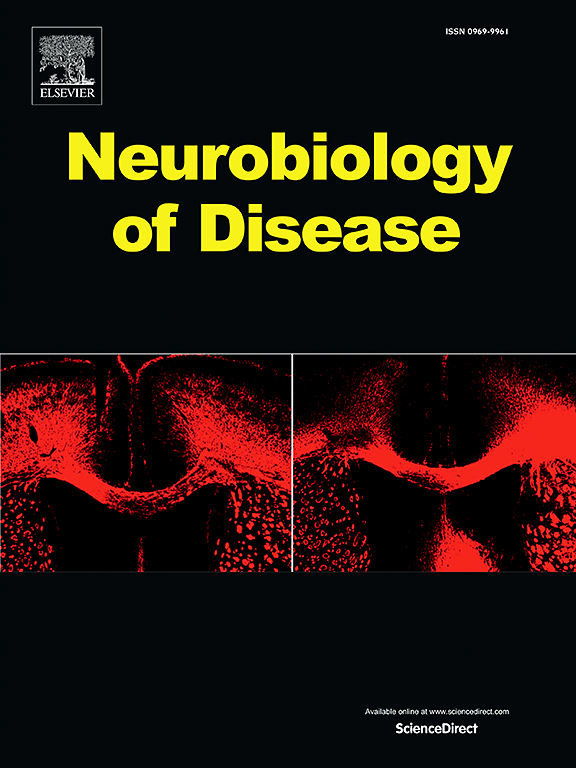Elevated 24-hydroxycholesterol levels counteract okadaic acid-induced tau hyperphosphorylation and neuronal morphology impairment
IF 5.1
2区 医学
Q1 NEUROSCIENCES
引用次数: 0
Abstract
Multiple findings underline a link between altered brain cholesterol metabolism and Alzheimer's disease (AD) pathogenesis. Physiologically, excess brain cholesterol is mainly converted into 24-hydroxycholesterol (24-OHC) by the neuron-specific enzyme CYP46A1. Of note, we previously observed in autopsy specimens from human AD brains that 24-OHC and, in parallel, CYP46A1 expression decrease at advanced stages, suggesting a possible cause-effect between these reductions and AD progression. In the present study, we aimed to investigate whether maintaining high levels of 24-OHC, by its exogenous administration or CYP46A1 overexpression, can counteract tau hyperphosphorylation and accumulation of prefibrillar tau oligomers. To create an AD-like in vitro model exhibiting tauopathy, we utilized okadaic acid (OKA), a chemical compound that induces tau hyperphosphorylation. Our data show that in 24-OHC-treated primary neurons derived from wild type mice and in neurons from CYP46A1 overexpressing mice (CYP46Tg) elevated oxysterol levels effectively prevented tau hyperphosphorylation and oligomerization. Furthermore, the dendritic arborization decrease induced by OKA was prevented, maintaining the organization and stability of the neuronal cytoskeleton. While hypothesized underlying molecular mechanisms (GSK3β, CDK5, ERK1/2, and PP2A) seem not to be involved, the protective effect of 24-OHC remains evident. The data highlight the positive effects of 24-OHC and the need to prevent its reduction in the brain. This can be achieved either through the exogenous administration of 24-OHC using suitable technologies or by maintaining elevated levels and the activity of the enzyme CYP46A1. These therapeutic approaches could be useful to prevent or slow AD progression.
24-羟基胆固醇水平升高可抵消冈田酸诱导的tau过度磷酸化和神经元形态损伤。
多项研究结果强调脑胆固醇代谢改变与阿尔茨海默病(AD)发病机制之间的联系。生理上,过量的脑胆固醇主要通过神经元特异性酶CYP46A1转化为24-羟基胆固醇(24-OHC)。值得注意的是,我们之前在人类AD大脑的尸检标本中观察到24-OHC和CYP46A1的表达在晚期减少,这表明这些减少与AD进展之间可能存在因果关系。在本研究中,我们旨在研究是否通过外源性给予或CYP46A1过表达维持高水平的24-OHC可以抵消tau过度磷酸化和纤维前tau寡聚物的积累。为了创建一个显示tau病变的ad样体外模型,我们使用了冈田酸(OKA),一种诱导tau过度磷酸化的化合物。我们的数据显示,在来自野生型小鼠的24- ohc处理的原代神经元中,以及来自CYP46A1过表达小鼠(CYP46Tg)的神经元中,升高的氧甾醇水平有效地阻止了tau蛋白的过度磷酸化和寡聚化。此外,还可以阻止OKA诱导的树突树突减少,维持神经元细胞骨架的组织和稳定性。虽然假设的潜在分子机制(GSK3β, CDK5, ERK1/2和PP2A)似乎没有参与,但24-OHC的保护作用仍然明显。这些数据强调了24-羟色胺的积极作用,以及防止其在大脑中减少的必要性。这可以通过使用合适的技术外源性给药24-OHC或通过维持高水平和CYP46A1酶的活性来实现。这些治疗方法可能有助于预防或减缓AD的进展。
本文章由计算机程序翻译,如有差异,请以英文原文为准。
求助全文
约1分钟内获得全文
求助全文
来源期刊

Neurobiology of Disease
医学-神经科学
CiteScore
11.20
自引率
3.30%
发文量
270
审稿时长
76 days
期刊介绍:
Neurobiology of Disease is a major international journal at the interface between basic and clinical neuroscience. The journal provides a forum for the publication of top quality research papers on: molecular and cellular definitions of disease mechanisms, the neural systems and underpinning behavioral disorders, the genetics of inherited neurological and psychiatric diseases, nervous system aging, and findings relevant to the development of new therapies.
 求助内容:
求助内容: 应助结果提醒方式:
应助结果提醒方式:


